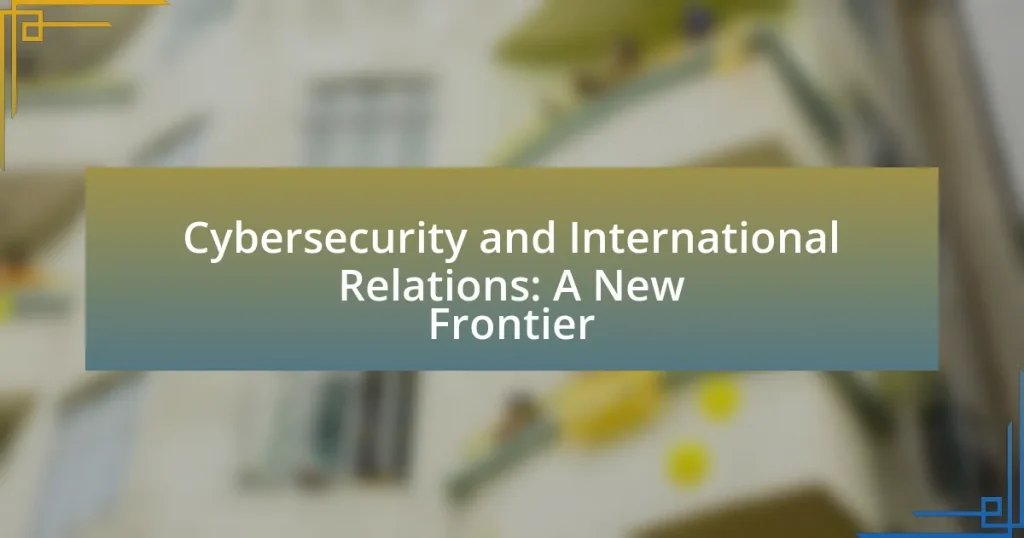Cybersecurity and International Relations represent the critical intersection of digital security and the diplomatic interactions between nations, emphasizing the growing importance of cybersecurity in national security and global stability. The article explores how cyber threats, such as state-sponsored attacks and election interference, impact diplomatic relations and necessitate international cooperation. Key components of cybersecurity, including threat intelligence, legal frameworks, and national strategies, are examined alongside the influence of nation-states on global cybersecurity policies. Additionally, the article addresses the challenges posed by differing national policies, geopolitical tensions, and emerging technologies, while highlighting the role of international organizations in fostering collaboration and establishing norms for cybersecurity.

What is Cybersecurity and International Relations?
Cybersecurity and International Relations refer to the intersection of digital security measures and the diplomatic, political, and strategic interactions between nations. This relationship has become increasingly significant as states recognize that cyber threats can undermine national security, influence international stability, and affect economic interests. For instance, the 2016 U.S. presidential election interference highlighted how cyber operations can impact political processes and international relations. As a result, countries are now prioritizing cybersecurity in their foreign policy agendas, leading to new frameworks for cooperation and conflict in the digital realm.
How do cybersecurity and international relations intersect?
Cybersecurity and international relations intersect through the increasing reliance of nations on digital infrastructure, which has become a critical component of national security. As countries engage in cyber warfare, espionage, and information manipulation, the implications for diplomatic relations and global stability are profound. For instance, the 2016 U.S. presidential election interference by Russian hackers exemplifies how cyber activities can strain diplomatic ties and lead to sanctions. Furthermore, international agreements, such as the Paris Call for Trust and Security in Cyberspace, highlight the need for collaborative frameworks to address cybersecurity challenges, illustrating the direct link between cyber threats and international diplomatic efforts.
What are the key components of cybersecurity in the context of international relations?
The key components of cybersecurity in the context of international relations include threat intelligence, international cooperation, legal frameworks, and national security strategies. Threat intelligence involves the collection and analysis of information regarding potential cyber threats, which is crucial for nations to protect their critical infrastructure. International cooperation is essential for sharing information and resources to combat cybercrime and cyber warfare, as evidenced by initiatives like the Budapest Convention on Cybercrime. Legal frameworks establish the rules and norms governing state behavior in cyberspace, while national security strategies integrate cybersecurity into broader defense policies, reflecting the increasing recognition of cyber threats as a national security concern. These components collectively shape how countries interact and respond to cybersecurity challenges on a global scale.
How do nation-states influence cybersecurity policies globally?
Nation-states influence cybersecurity policies globally through legislation, international agreements, and strategic partnerships. For instance, countries like the United States and China shape global cybersecurity norms by establishing frameworks such as the Budapest Convention on Cybercrime, which promotes international cooperation in combating cybercrime. Additionally, nation-states often engage in bilateral and multilateral discussions to align their cybersecurity strategies, as seen in forums like the G7 and NATO, where member states collaborate on best practices and threat intelligence sharing. This influence is further evidenced by national cybersecurity strategies that prioritize critical infrastructure protection and the establishment of regulatory bodies, which set standards that can affect global cybersecurity practices.
Why is cybersecurity a critical issue in international relations today?
Cybersecurity is a critical issue in international relations today because it poses significant risks to national security, economic stability, and diplomatic relations. The increasing frequency and sophistication of cyberattacks, such as the 2020 SolarWinds hack, which compromised multiple U.S. government agencies, highlight the vulnerabilities nations face in the digital realm. Additionally, state-sponsored cyber activities, like those attributed to Russia and China, can undermine trust between countries and escalate geopolitical tensions. As nations rely more on digital infrastructure, the potential for cyber warfare and espionage becomes a pressing concern, necessitating international cooperation and robust cybersecurity measures to safeguard national interests.
What recent events highlight the importance of cybersecurity in global politics?
Recent events such as the SolarWinds cyberattack and the Colonial Pipeline ransomware incident underscore the critical importance of cybersecurity in global politics. The SolarWinds attack, which compromised numerous U.S. government agencies and private companies, demonstrated how state-sponsored cyber operations can disrupt national security and economic stability. Similarly, the Colonial Pipeline attack led to significant fuel supply disruptions across the Eastern United States, highlighting vulnerabilities in critical infrastructure. These incidents illustrate that cybersecurity is not just a technical issue but a vital component of national security and international relations, as nations grapple with the implications of cyber threats on their sovereignty and economic interests.
How do cyber threats impact national security and diplomatic relations?
Cyber threats significantly undermine national security and strain diplomatic relations by enabling espionage, disrupting critical infrastructure, and fostering distrust among nations. For instance, state-sponsored cyberattacks, such as the 2016 Russian interference in the U.S. elections, illustrate how cyber threats can manipulate political processes and create geopolitical tensions. Additionally, incidents like the 2020 SolarWinds hack demonstrate vulnerabilities in national security systems, leading to heightened concerns about cybersecurity among allied nations. These events contribute to a climate of suspicion, prompting countries to bolster their cyber defenses and reconsider diplomatic engagements, ultimately reshaping international relations.

What are the major challenges in cybersecurity and international relations?
The major challenges in cybersecurity and international relations include state-sponsored cyberattacks, the lack of international norms and agreements, and the difficulty in attributing cyber incidents to specific actors. State-sponsored cyberattacks, such as those attributed to Russia and China, undermine national security and create tensions between countries. The absence of established international norms complicates cooperation and response strategies, as nations often have differing views on acceptable behavior in cyberspace. Additionally, the challenge of accurately attributing cyberattacks makes it difficult to hold perpetrators accountable, leading to a cycle of mistrust and retaliation among nations.
How do differing national policies affect global cybersecurity efforts?
Differing national policies significantly impact global cybersecurity efforts by creating inconsistencies in regulations, cooperation, and threat responses. For instance, countries with stringent data protection laws, like the European Union’s General Data Protection Regulation (GDPR), impose strict compliance requirements that can hinder international collaboration on cybersecurity initiatives. Conversely, nations with lax cybersecurity regulations may become safe havens for cybercriminals, undermining collective security efforts. Additionally, varying approaches to cybersecurity, such as offensive versus defensive strategies, can lead to conflicts and mistrust among nations, complicating joint efforts to combat cyber threats. This fragmentation is evident in the 2021 Cybersecurity and Infrastructure Security Agency (CISA) report, which highlights how differing national policies can create vulnerabilities that adversaries exploit, ultimately weakening global cybersecurity resilience.
What are the implications of varying cybersecurity laws across countries?
Varying cybersecurity laws across countries lead to significant implications for international cooperation, data protection, and cybercrime enforcement. These discrepancies create challenges for multinational corporations that must navigate different legal frameworks, potentially increasing compliance costs and operational risks. For instance, the European Union’s General Data Protection Regulation (GDPR) imposes strict data privacy requirements, while countries like the United States have a more fragmented approach to data protection. This inconsistency can hinder cross-border data flows and complicate incident response efforts, as companies may struggle to comply with multiple regulations simultaneously. Furthermore, differing laws can affect the prosecution of cybercriminals, as jurisdictions may have varying definitions of cyber offenses and levels of cooperation in law enforcement. This can lead to safe havens for cybercriminals in countries with lax laws, undermining global cybersecurity efforts.
How do geopolitical tensions influence cybersecurity cooperation?
Geopolitical tensions significantly hinder cybersecurity cooperation among nations. When countries are in conflict or have strained relations, they often prioritize national security over collaborative efforts, leading to a lack of trust and information sharing. For instance, the ongoing tensions between the United States and China have resulted in both nations enhancing their cyber defenses while simultaneously accusing each other of cyber espionage, which undermines potential cooperative frameworks like the 2015 U.S.-China Cyber Agreement aimed at reducing cyber theft. This adversarial environment fosters a competitive rather than collaborative approach to cybersecurity, making it difficult to establish joint initiatives or share critical threat intelligence.
What role do international organizations play in cybersecurity?
International organizations play a crucial role in cybersecurity by facilitating cooperation among nations, establishing norms, and providing frameworks for addressing cyber threats. For instance, organizations like the United Nations and the International Telecommunication Union promote dialogue and collaboration on cybersecurity issues, helping to create international standards and best practices. Additionally, the North Atlantic Treaty Organization (NATO) enhances collective defense against cyber threats through joint exercises and information sharing among member states. These efforts are essential in combating cybercrime and ensuring a coordinated response to cyber incidents, as evidenced by initiatives such as the Global Forum on Cyber Expertise, which aims to build capacity and share knowledge among countries.
How do organizations like the UN and NATO address cybersecurity issues?
Organizations like the UN and NATO address cybersecurity issues through collaborative frameworks and strategic initiatives aimed at enhancing global security. The UN promotes cybersecurity through its Group of Governmental Experts, which focuses on developing norms and principles for responsible state behavior in cyberspace. NATO, on the other hand, has established a Cyber Defence Policy that emphasizes collective defense and the integration of cyber capabilities into its military operations. Both organizations conduct joint exercises, share intelligence, and provide training to member states to strengthen their cybersecurity posture. For instance, NATO’s Cooperative Cyber Defence Centre of Excellence in Estonia serves as a hub for research and training in cyber defense, demonstrating a commitment to enhancing member states’ capabilities against cyber threats.
What frameworks exist for international cooperation on cybersecurity?
Several frameworks exist for international cooperation on cybersecurity, including the Budapest Convention on Cybercrime, the European Union’s Cybersecurity Strategy, and the NATO Cyber Defence Policy. The Budapest Convention, established in 2001, is the first international treaty aimed at addressing internet and computer crime by harmonizing national laws and fostering international cooperation. The European Union’s Cybersecurity Strategy, updated in 2020, emphasizes collective defense and resilience against cyber threats among member states. NATO’s Cyber Defence Policy, adopted in 2016, focuses on enhancing the alliance’s cyber defense capabilities and promoting collaboration among member nations. These frameworks facilitate information sharing, joint exercises, and coordinated responses to cyber incidents, thereby strengthening global cybersecurity efforts.

What are the future trends in cybersecurity and international relations?
Future trends in cybersecurity and international relations include increased state-sponsored cyberattacks, the rise of cyber diplomacy, and the integration of artificial intelligence in cybersecurity measures. State-sponsored cyberattacks are becoming more sophisticated, with countries like Russia and China leveraging cyber capabilities to achieve geopolitical objectives, as evidenced by incidents such as the SolarWinds hack in 2020. Cyber diplomacy is emerging as nations seek to establish norms and agreements to govern cyberspace, highlighted by initiatives like the Paris Call for Trust and Security in Cyberspace. Additionally, the integration of artificial intelligence is enhancing threat detection and response capabilities, as organizations adopt AI-driven tools to combat evolving cyber threats. These trends indicate a growing intersection between cybersecurity and international relations, shaping global security dynamics.
How is technology shaping the future of cybersecurity in international relations?
Technology is significantly shaping the future of cybersecurity in international relations by enhancing threat detection, response capabilities, and fostering international cooperation. Advanced technologies such as artificial intelligence and machine learning enable nations to analyze vast amounts of data for identifying cyber threats more efficiently. For instance, the integration of AI in cybersecurity systems allows for real-time threat assessment and automated responses, which can mitigate risks before they escalate into larger conflicts. Furthermore, technology facilitates collaborative frameworks like the Budapest Convention on Cybercrime, promoting information sharing and joint exercises among countries to strengthen collective cybersecurity measures. This technological evolution is crucial as cyber threats increasingly transcend borders, necessitating a unified global approach to cybersecurity in international relations.
What emerging technologies pose new challenges for cybersecurity?
Emerging technologies such as artificial intelligence, the Internet of Things (IoT), quantum computing, and blockchain pose new challenges for cybersecurity. Artificial intelligence can be exploited for sophisticated cyberattacks, enabling attackers to automate and enhance their methods. The proliferation of IoT devices increases the attack surface, as many devices lack adequate security measures, making them vulnerable to exploitation. Quantum computing threatens traditional encryption methods, potentially rendering current security protocols obsolete. Blockchain, while offering secure transaction capabilities, can also be misused for illicit activities, complicating regulatory oversight. These technologies collectively create a dynamic landscape that requires continuous adaptation in cybersecurity strategies.
How can nations prepare for future cybersecurity threats?
Nations can prepare for future cybersecurity threats by implementing comprehensive cybersecurity strategies that include robust infrastructure, continuous training, and international collaboration. A strong cybersecurity infrastructure involves investing in advanced technologies, such as artificial intelligence and machine learning, to detect and respond to threats in real-time. Continuous training for government personnel and private sector employees ensures that they are equipped with the latest knowledge and skills to combat evolving cyber threats. Furthermore, international collaboration is essential, as cyber threats often transcend borders; nations can share intelligence and best practices through partnerships and treaties, enhancing collective security. For instance, the European Union’s General Data Protection Regulation (GDPR) has set a precedent for data protection standards that can be adopted globally, demonstrating the effectiveness of collaborative frameworks in addressing cybersecurity challenges.
What best practices can countries adopt to enhance cybersecurity?
Countries can enhance cybersecurity by implementing a comprehensive national cybersecurity strategy that includes risk assessment, public-private partnerships, and continuous training. A national strategy allows for a coordinated approach to identify vulnerabilities and allocate resources effectively. Public-private partnerships facilitate information sharing and collaboration between government and industry, which is crucial for addressing emerging threats. Continuous training ensures that personnel are equipped with the latest skills and knowledge to respond to cyber incidents. According to the World Economic Forum’s Global Cybersecurity Outlook 2022, countries that adopt these practices experience a significant reduction in cyber incidents, demonstrating their effectiveness in enhancing national cybersecurity.
How can nations collaborate to strengthen their cybersecurity posture?
Nations can collaborate to strengthen their cybersecurity posture by establishing international agreements and frameworks for information sharing, joint training exercises, and coordinated responses to cyber threats. For instance, the European Union’s General Data Protection Regulation (GDPR) has set a precedent for cross-border data protection standards, encouraging nations to align their cybersecurity policies. Additionally, initiatives like the NATO Cooperative Cyber Defence Centre of Excellence facilitate knowledge sharing and best practices among member states, enhancing collective defense capabilities against cyber attacks. These collaborative efforts are essential as cyber threats often transcend national borders, requiring a unified approach to effectively mitigate risks and respond to incidents.
What strategies can be implemented to improve public-private partnerships in cybersecurity?
To improve public-private partnerships in cybersecurity, organizations can implement strategies such as establishing clear communication channels, creating joint task forces, and sharing threat intelligence. Clear communication channels facilitate the exchange of information between public and private entities, ensuring that both sectors are aligned on cybersecurity goals and strategies. Joint task forces, which combine resources and expertise from both sectors, can enhance the effectiveness of cybersecurity initiatives by fostering collaboration on specific projects or incidents. Sharing threat intelligence allows both public and private organizations to stay informed about emerging threats and vulnerabilities, leading to more proactive defenses. According to the Cybersecurity and Infrastructure Security Agency (CISA), effective collaboration between public and private sectors is essential for enhancing national cybersecurity resilience.















